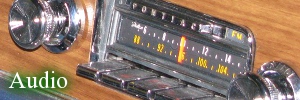















Vehicle Cockpit Layout Provides Comfort, Operational Safety |
|---|
 Topics: Daniel Pund
Topics: Daniel Pund
|
John Birchard
May 17, 2003
 Listen to Vehicle Cockpit Layout Provides Comfort, Operational Safety - RealPlayer - 365KB - 2:57
Listen to Vehicle Cockpit Layout Provides Comfort, Operational Safety - RealPlayer - 365KB - 2:57
The levers, knobs, switches, pedals and buttons you face when you sit in the driver's seat of a new car or truck control an array of operational, safety, comfort and convenience features that can help you enjoy the drive or make it irritating and even unsafe.
After years of observing auto manufacturers, the senior editor of Car & Driver magazine, Daniel Pund, says there are national characteristics that show up in their vehicles.
"The Japanese tend to be very, very good at ergonomics," he said. "Everything is exactly where you expect it to be. There are no surprises and, generally, things operate in a logical and fairly simple manner. Germans tend to be a little… how shall we say, a little dour [stern], a little dark but the quality tends to be very, very good and ergonomics tends to be fairly decent. It's really the Americans that are pulling up the rear on that."
In discussions about vehicle cockpit layouts, the word "intuitive" often comes up, as in these remarks concerning power seat controls, from the manager of product strategy for Volkswagen of America, Stefan Krebsfanger.
"For those units, it is very important that the buttons make logical, intuitive sense to the consumer so that they just don't have to think much about how to use them, because they also don't want to be distracted from traffic, from the 'eyes on the road' situation," he said.
The colors used in the car's interior should be pleasing but, as Kevin Hunter of Toyota's California design studio points out, they can also contribute to safety.
"For instance, instrument panel colors, they have to be especially in Toyota's way of thinking should be a certain 'value' so that they're not causing a reflection back into the [windshield] glass," said Mr. Hunter.
Sometimes, in their attempts to beat the competition, manufacturers may use technology that is too advanced for their customers. Car & Driver's Daniel Pund says BMW did that with their latest 7-series car and a feature called "I-Drive".
"You go through a number of menus, just as if you were working on your laptop or your desktop computer," he said. "And it's very difficult to use on the road, because it tends to take a number of steps and takes your attention away from driving."
And, finally, a so-called "cheap" car does not have to use interior materials that look and feel cheap, according to Toyota's Kevin Hunter.
"From the point of view of the buyer, they're expecting more," he said. "Their demands are increasing as far as sophistication. We think that we can have a distinct advantage if we increase the sense of material quality and design, overall design quality, that we can express a much higher level product content appearance that way and be better than the competitors."
Looking, feeling, sounding better than the competitors… in a hundred ways, auto manufacturers work to make their products appeal to the car buying public. For the designers of vehicle interiors, it's truly an "inside job."
